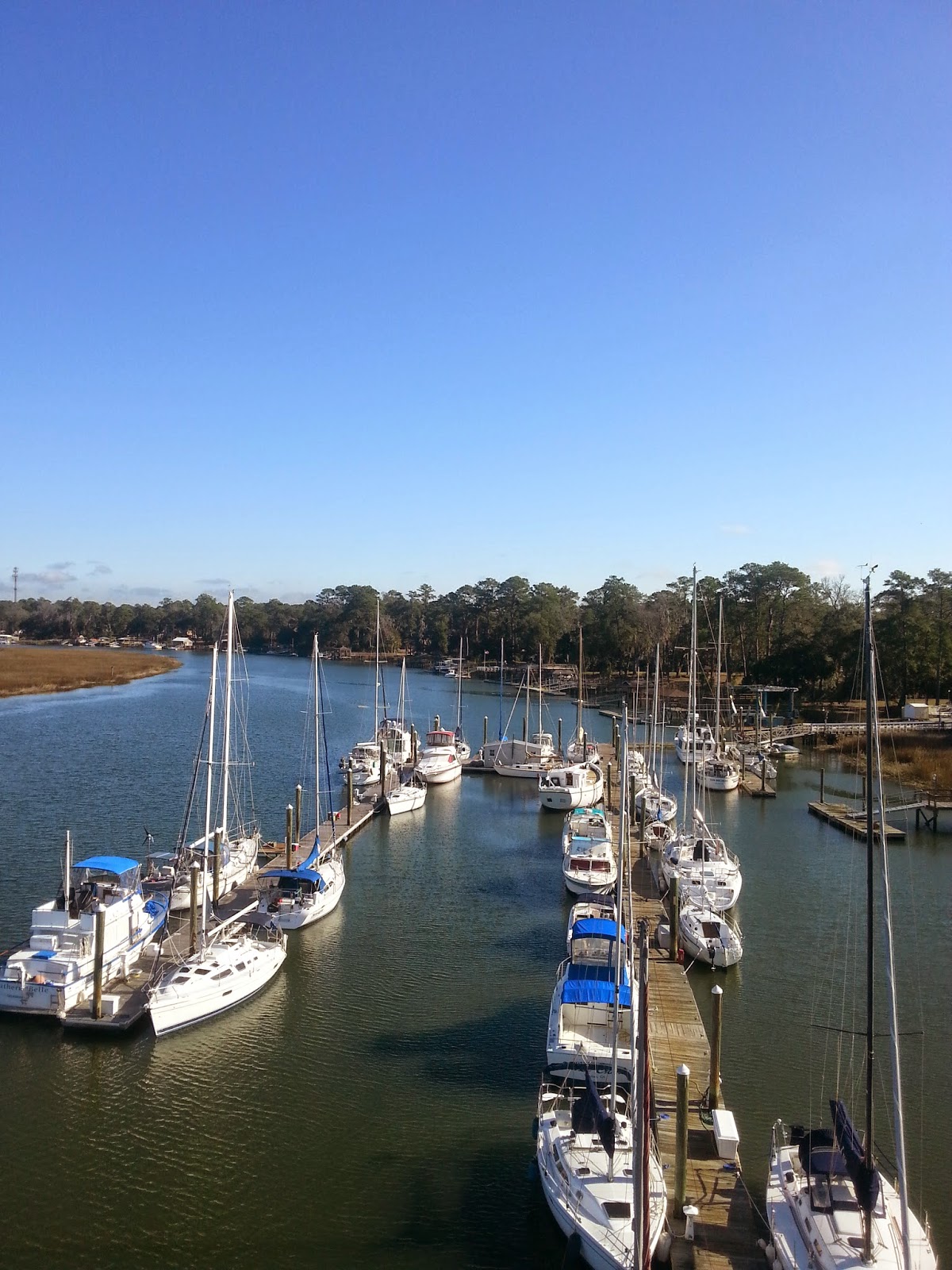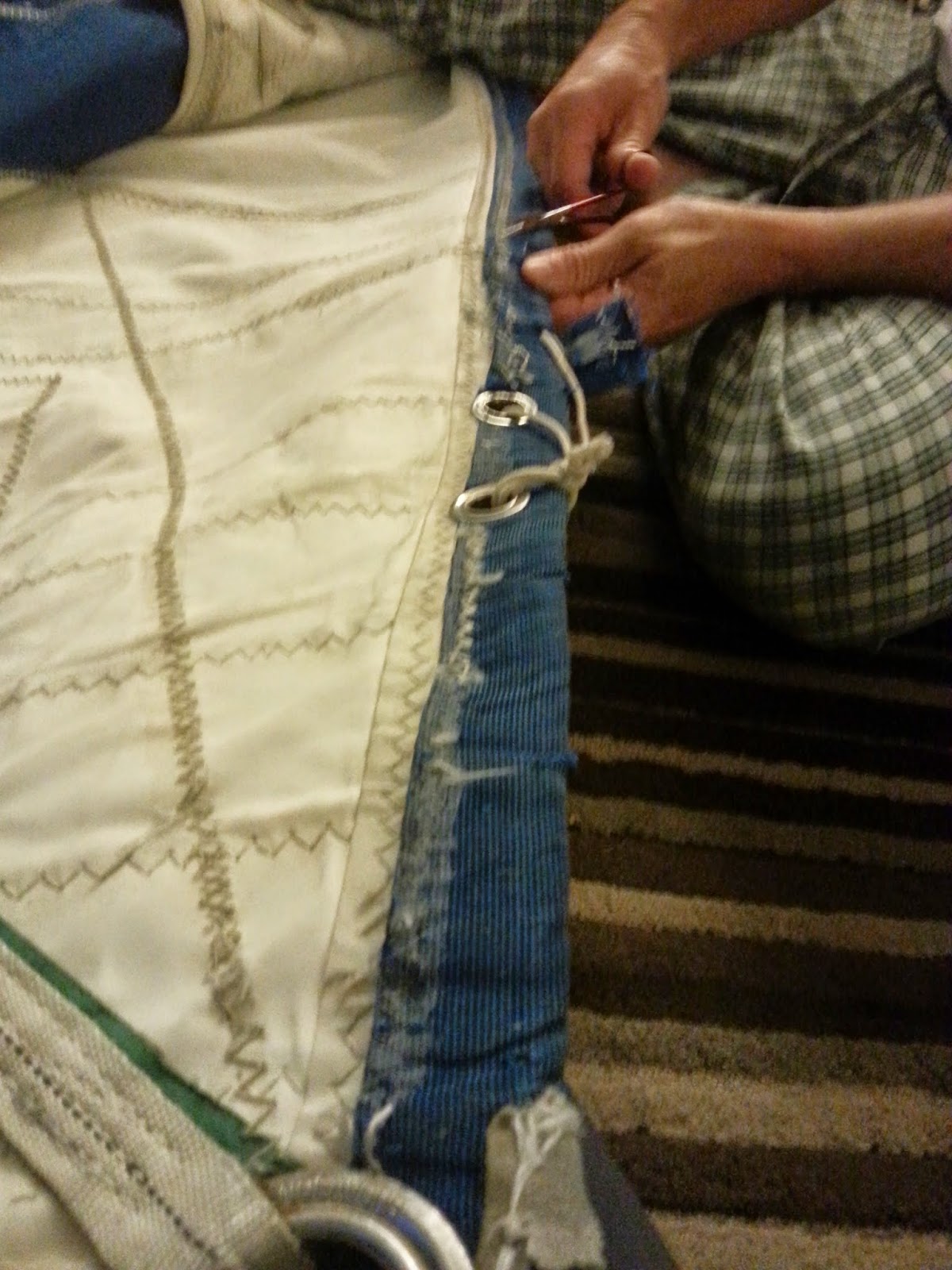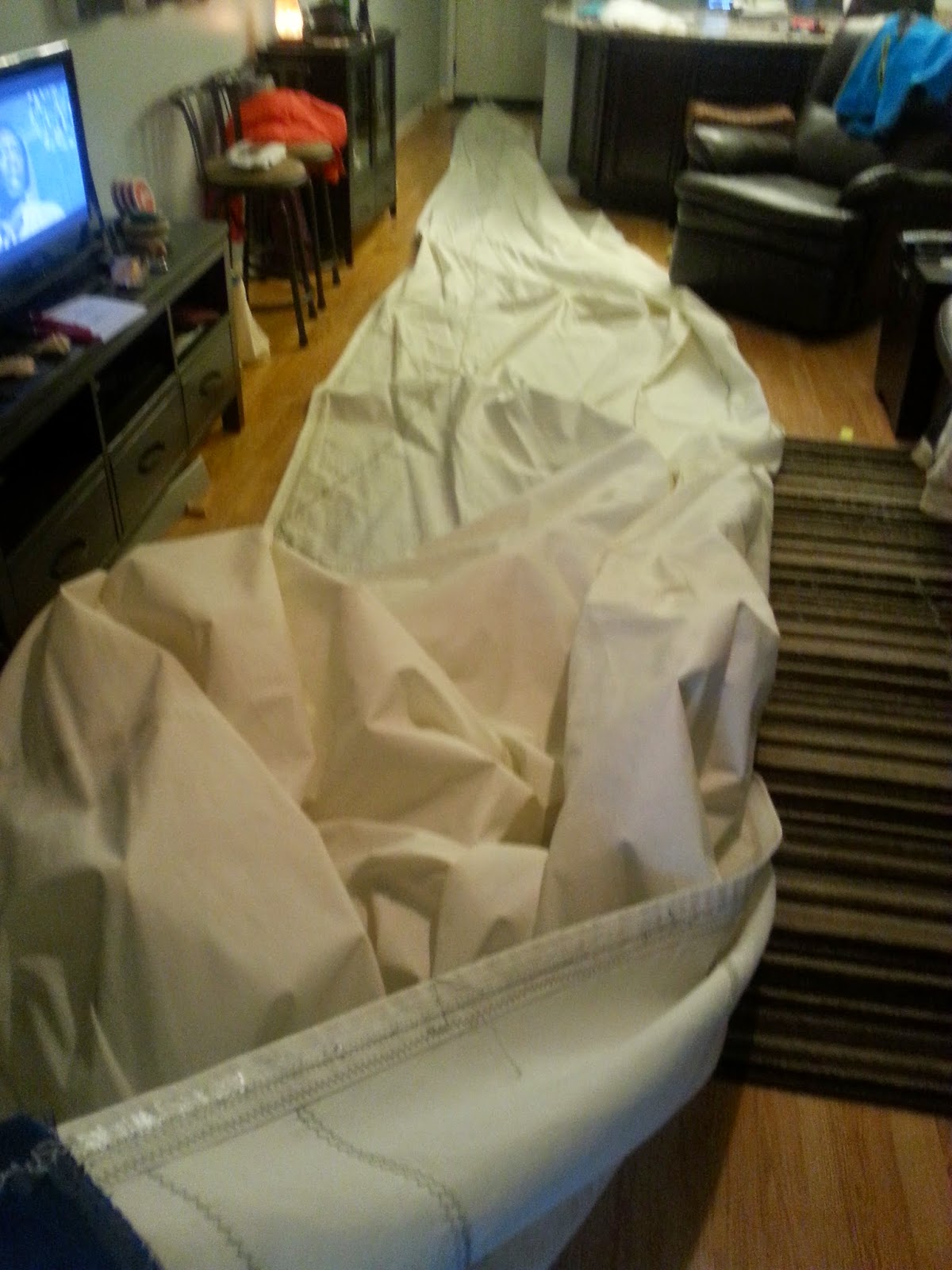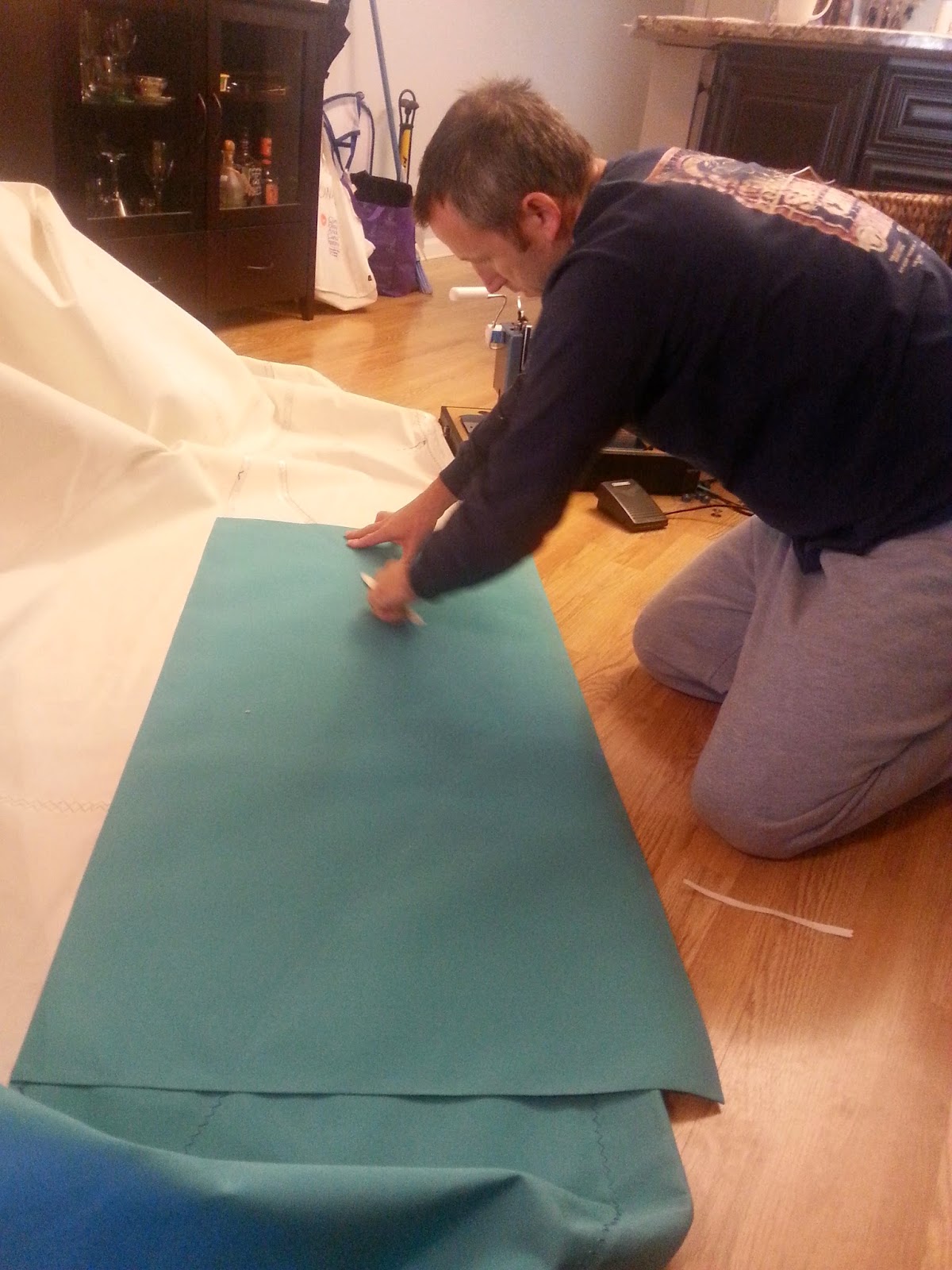If you
read the last post, waaaay back in January, you know we were working on replacing the sacrificial on the jib/genoa**. Between starting my last semester of Culinary school, working part time at the bakery, and Mark working full time and on other projects, it took 5 weeks to complete this sucker – but we FINISHED! And it looks good.
A little tiny bit of backstory? I am not a seamstress. Or a canvas maker. And I’m only just becoming a sailor. So how to do this? Grab the Sailrite and go Step. By. Step. I started by ordering two books:
 |
| I think I got these on Amazon – but just shop around to find the best price. |
Both books have slightly different information and include a variety of canvas work – not just sail repair. And lordy lord do we have some canvas projects on our list…
I also watched the videos on Sailrite – and then combined all of the info into something that worked for us and our sail.
Next step was to take down the Genny. We’d never done this before and we learned a BIG lesson* here. After the fact.
 |
| Up the mast I went… |
 |
…to unhook the top of the sail from the top of the roller furling.
(it was wired in, not just attached with that key ring thingamabobber.) |
 |
| It’s much, much larger than it looks. And heavier. |
Before taking the sail off of the track/boat, I made sure to take some pics of how it was attached. I knew this was going to be a long project and that my memory was not going retain all of the little nuances.
 |
| For example, how the lines were tied to that ring. |
Then it went home to be dismantled, step by step. Also with photos along the way.
 |
Stretched out, it went from our front door to our back door –
the longest run in the condo. |
We took it outside to lay it out and measure the exact length so I could order enough Sunbrella. Close your eyes and use your imagination. It was too much work as it was, so I didn’t bother to take pics.
 |
| Detailed pics of every little piece before we took it all off. |
 |
We even learned what these lines are for (sail trim).
I’ll admit, we didn’t even realize they existed before this project…
So much learning! |
 |
| Starting to remove the stitches. |
 |
| Naked! |
Next we started cutting panels. I ordered my Sunbrella from Sailrite in the marine grade – which is 46″ wide. So each panel was 46″ wide… I just had to measure from the top of the panel around the sail to the back. And then cut to the appropriate measurements. The sail tapers throughout – it’s not a straight line. So I really tried to get accurate measurements and cuts. Mark set up a great cutting station and we started out using pinking shears. I instantly decided to go with a hot knife to save time/melt the edges (it’s a plastic-y acrylic material) to keep the edges from fraying. But we didn’t want to buy the pricey knife from Sailrite, so we grabbed a
Dremel hot tool from Amazon for $20 and it worked like a charm.
 |
| First panel! |
Each of the four sides is taped down using basting tape – also from Sailrite. I found it cheaper, later,
on Defender. I’d grossly underestimated how much I needed and had to re-order. The tape from Defender is the same brand, but narrower and a bit less sticky. But worth the few dollars less per roll.
Before attaching the panels, we determined which side was up – the way the air flowed over the sail. And we placed the panels so that the air would flow over the overlapped panels smoothly – not against the over lap, which would pull against the seams when sailing. This took a little pre-planning. I also folded over the three sides that would be exposed – the top on the front and back as well as the down-wind side that sits on top. Geez, I hope that makes sense to you.
I also taped the angled stitch areas – the tape apparently seals the stitches, so I tried to have tape anywhere I was going to sew. I got into a routine of running the tape above the previously stitched areas. I could feel the old stitch holes while I was sewing, so if I couldn’t see where the tape was under the Sunbrella, I still knew where I’d placed it. I also learned, thankfully in the research stage, that you should not sew over previously sewn areas, as it can weaken the sail. So my new panels are all slightly larger than the original panels in order to avoid stitching in the same spots.
 |
| Moving right along. |
 |
| Not the most comfortable way to sew. Glad I do yoga! |
 |
By the end, Mark couldn’t resist jumping in on the fun.
Here he’s folding over the edges and taping everything down so I can sew it. |
 |
| Most of the Naugahyde was stitch-able by the Sailrite – but not around the clew. |
Mark ended up doing a bit of hand sewing in a few super-thick reinforced areas, but other than that, the Sailrite pretty much breezed through the entire project. The most difficult area was, as expected, the widest part of the sail. Rolling all of that heavy duty fabric up and working it through the machine was a challenge. If that arm was longer and taller, it would improve the design of the machine significantly. Even so, the project is now DONE. Can I get a whoop whoop!

 |
| A well deserved beverage on a sunny February day to top it off. |
* Big lesson. You don’t have to go up the mast to unhook the sail. Duh, right? Well we didn’t figure this out until the end of the project. After I’d gone back up the mast to hang the sail on an on/off windy day that really made it a sucky (and bruise-y) ordeal. We had what I liked to refer to as the Mystery Blue Line on the boat – and had no clue what it was for. The day I went up to unhook the genoa I saw that the Mystery Blue Line came out of the top of the mast and was attached to the top of the roller furling. I shouted this new found info down to Mark and we just figured it was to lower the entire roller furling pole thingy. Turns out, the top of the roller lowers and the car thing slides down the roller furling pole. You know, so you can lower it down to the deck of the boat and unhook the top of the sail without having to go up the mast. Oh well. At least we both got good workouts that day. Even if I did have to go through the next couple of weeks with people asking me if “everything was ok, ya know, at home, with Mark…” Lesson Learned.
**Another handy thing we learned is that we have a genoa – and that while a genoa is a jib, a jib is not always a genoa. We thought they were interchangeable terms, as many MANY things have more than one name in the sailing world. So annoying. However, turns out the front sail is a jib – and if that jib is 100% or less, it’s a jib, but if it’s over 100%, it’s a genoa. Or something along those lines. Go here for a more technical description.
About Author
Artist, food nerd, SUP/yoga enthusiast and travel obsessed blogger – chronicling the process of going from land to sea. Selling all of her worldly possessions so that she can set sail into the sunset with her husband and two dachshunds – searching for that next sunrise paddle. Follow along. It’ll be fun 🙂

























FANTASTIC ! ! ! ! BEAUTIFUL ! ! ! ! ! AND WHOOP WHOOP ! ! ! ! ! ! You did a FANTASTIC JOB ! ! ! !
Candy/Mom 🙂
FANTASTIC ! ! ! ! BEAUTIFUL ! ! ! ! ! AND WHOOP WHOOP ! ! ! ! ! ! You did a FANTASTIC JOB ! ! ! !
Candy/Mom 🙂
Hi,
I've enjoyed reading quite a bit of your blog, especially this last one with the unknown halyard :-))
It occurs to me as you are new to the subject and I haven't seen it mentioned anywhere on your to-do list, have your thought about renewing your standing rigging? I guess your boat is 10-15 years old and having been chartered it probably has its original rigging. If you plan to head offshore for an extended period I would not be keen on doing it with end of life wire. Just a thought!
Best regards
John
Thanks John – for both reading and commenting. I love comments.
We actually have plans to get the rigging/sails inspected by someone who knows what they are doing as soon as we have the boat pulled. This should happen in the next few months. That way we will be able to easily budget for any repairs/replacements. I need to go back to our purchase paper work and see if they are original or if they were replaced by the previous owner. I certainly don't want to attempt any extended sails until we know we've got solid equipment.